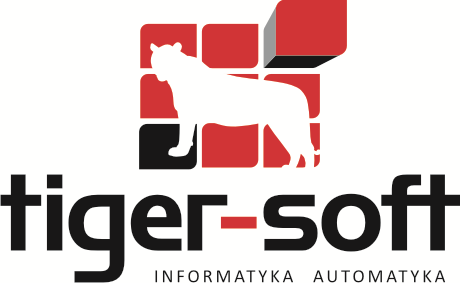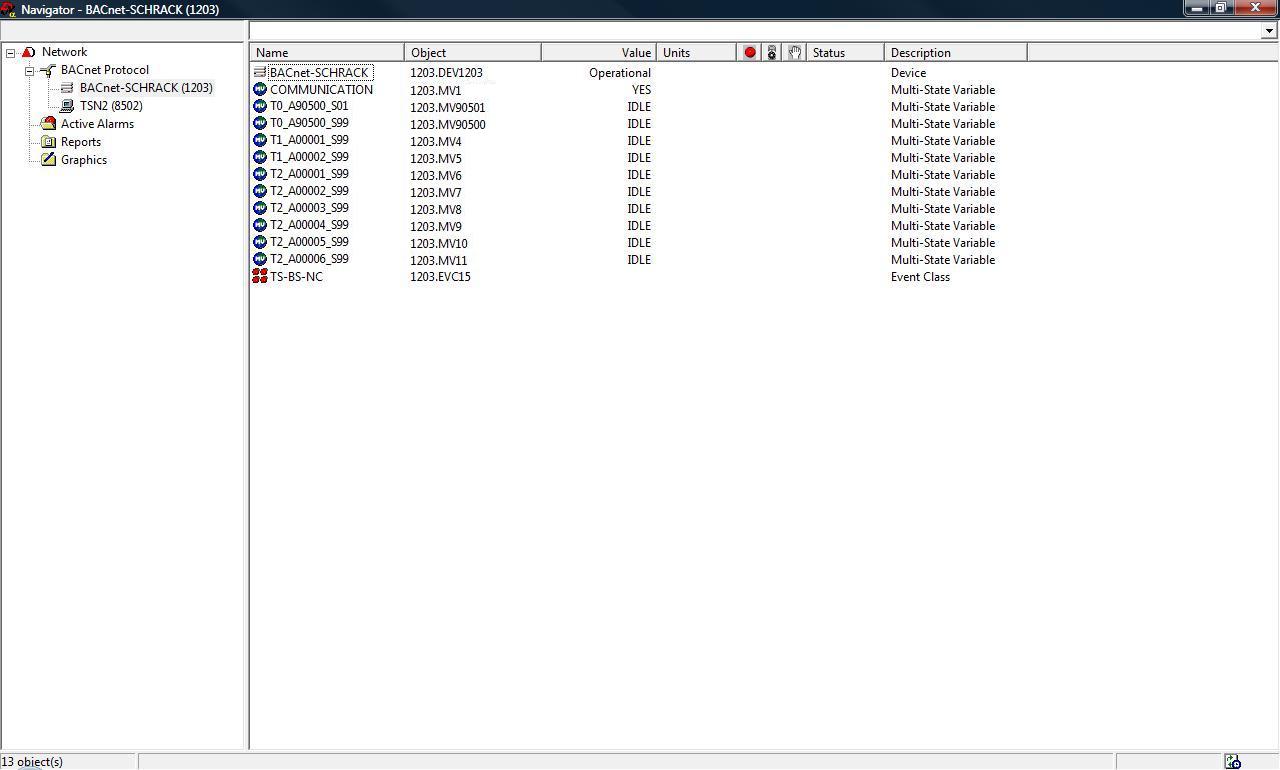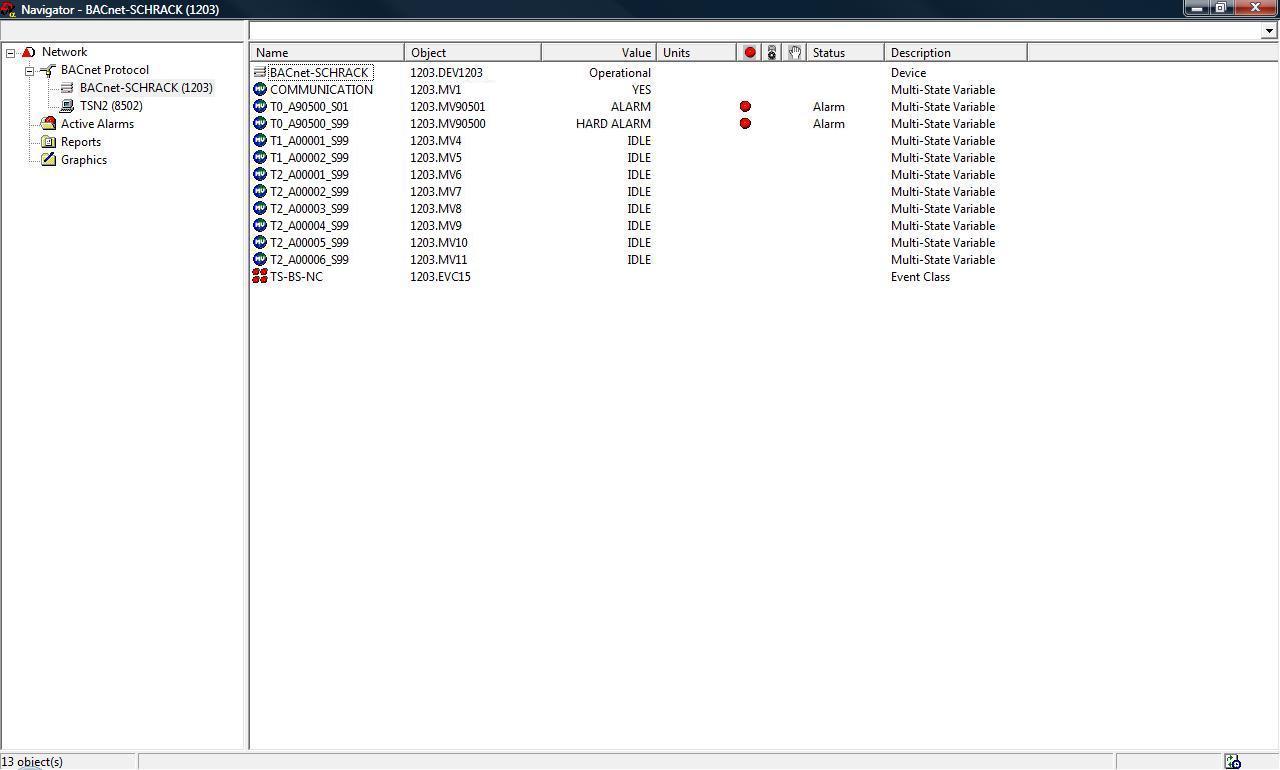
Warsaw 15.05.2012
BACnet_SCHRACK VER. 3.2
MANUAL

Mrowcza 243
04-697 Warszawa
tel./fax (+48 22) 46-88-023
e-mail: tiger-soft@tiger-soft.com.pl
Table of contents
1) Introduction
2) Pre-configured hardware solution
3) Installing the I/O driver
4) Software registration
5) Configuring the BACnet_SCHRACK
6) Configuring a BMS
7) Starting and stopping the BACnet_SCHRACK
A BACnet_SCHRACK ver. 3.2 is a communication driver which allows to connect BMS system
with a fire protection system from Schrack Seconet. The driver may be connected to a Schrack central unit with the help
of the computer serial port (RS232) or ETHERNET network card and the Integral Standard Protocol (ISP).
The Schrack central has to have one of the following modules:
B3-USI4,B3-LPI,B4-USI for a RS232 or network cards like B5-NET2-FXM for an ETHERNET.
The driver can be connected to BMZ Integral IP, Integral C or Integral system.
The interface for a BMS system is built on BACnet/IP standard (ISO 16484-5:2003).
Bacnet_SCHRACK includes the following features:
2) Pre-configured hardware solution
A BACnet_SCHRACK ver. 3.2 can be delivered with dedicated hardware. It is usually small PC computer with Microsoft Windows Embedded operating system.
This computer has already BACnet_SCHRACK installed and registered. So, there is no need to do procedures from point 3 and 4 of this manual.
However there is usually a need to change a Configuration.cbs file as it was described in point 5. Usually a Schrack panel is connected to COM1.
A BACnet_SCHRACK service is configured to start automatically after an operating system starts. You can connect to a computer by using a Remote Desktop.
A computer has one of following default parameters:
|
Computer name |
User |
Password |
Workgroup |
IP address |
| TSBSCHRACK1 | Administrator | $tsbschrack01 | TS | 192.168.1.101 |
| TSBSCHRACK2 | Administrator | $tsbschrack02 | TS | 192.168.1.102 |
Run BACnet_SCHRACK_INSTALL.EXE.Installation software will put BACnet_SCHRACK files into the C:\Program Files\TIGER_SOFT\BACnet_SCHRACK_3_2 directory or another directory chosen by the user. Shortcuts to the manual and registration software exist in the group BACnet_SCHRACK ver. 3.2 (access from the Start menu). The driver is installed as a service.
BACnet_SCHRACK should be registered after installation using TIGER-SOFT internet service.
SOFTWARE REGISTRATION from BACnet_SCHRACK group should be started first. This program generates file gen_lic.lic and
saves it in the main driver directory. Then you have to connect to
http://www.tiger-soft.com.pl/Registration/registration.html,
fill the form and receive the registration code. This code should be put to the editable field in the SOFTWARE REGISTRATION.
Press OK to finish registration process.
5)Configuring the BACnet_SCHRACK
The file - Configuration.cbs is used for the driver configuration. It exists in the same directory like the BACnet_SCHRACK.exe.
An example of the file is presented below.
# BACnet_SCHRACK - configuration file
# RS232_ETH - RS232 (COM) or ETHERNET connection. Possible values 0-RS232 1-ETH
# COM parameters
# NR_COM from the range 1-99
# BAUD_RATE [bits/s]. Possible values: 9600,14400,19200,38400,57600,115200
# PARITY N-None,E-Even,O-Odd
# ETH parameters
# CL_IP is a local driver ip address
# SCHRACK_IP is a Schrack-Seconet central ip address
# USER is an user name defined in a central
# PASSWORD is an user password defined in a central
# TIMEOUT [s]. Possible values from the range 1-9999 [s]
# ISP parameters
# TOKENTIME [ms]. Possible values from the range 30-250 [ms]
# CLIENT - Address of the client has the following structure Subnet.Node.Client, where Subnet=0-63;
Node=0-63; Client=0-7;
RS232_ETH=1
NR_COM=1
BAUD_RATE=57600
PARITY=E
#ETH
CL_IP=192.168.1.53
SCHRACK_IP=192.168.1.71
USER=Tiger-Soft
PASSWORD=Tiger-Soft
TIMEOUT=30
TOKENTIME=250
CLIENT=0.0.1
# *****BACnet*****
# DEVICE_ID is a BACnet device number.
# EVC is an Event Class number.
# DEVICE_NAME is a BACnet device name.
# EVC_NAME is an Event Class name.
# LOCAL_IP is a local ip address.
# LOCAL_PORT is used by the driver for communication with a BMS system.
# DESTINATION_PORT - it is a port of computers in a network, dedicated for the BACnet. Default is 47808.
# BACnet_TIMEOUT[s] - Timeout for the BACnet communication process. Possible values from the range 1-9999 [s].
# NOTIFICATION_PROCESS_ID - identification of the process in the receiving device for which the notification is intended.
# NOTIFICATION_PRIORITY_ALARM or FAULT - notifications priorities for sending an alarm or an fault notifications.
# NOTIFICATION_PRIORITY_NORMAL is used for an acknowledge notification after user confirmation of an alarm or a fault.
# NOTIFICATION_RECIPIENT_UDP - Notification recipient ip number for UDP client.
# ROUTER - router (UDP->ETHERNET) ip
# DNET - Local Network Number set in the router
# NOTIFICATION_RECIPIENT_ETHERNET - Notification recipient MAC number for ETHERNET client.
DEVICE_ID=1203
EVC=15
DEVICE_NAME=BACnet-SCHRACK
EVC_NAME=TS-BS-NC
LOCAL_IP=192.168.1.101
LOCAL_PORT=47808
DESTINATION_PORT=47808
BACnet_TIMEOUT=60
NOTIFICATION_PROCESS_ID=0
NOTIFICATION_PRIORITY_ALARM=100
NOTIFICATION_PRIORITY_FAULT=120
NOTIFICATION_PRIORITY_NORMAL=150
NOTIFICATION_RECIPIENT_UDP=192.168.1.100
#ROUTER=192.168.1.105
DNET=10001
#NOTIFICATION_RECIPIENT_ETHERNET=00:16:b6:90:f1:91
#NOTIFICATION_RECIPIENT_ETHERNET=00:07:E9:B0:7C:70
# Points
# CENTRAL - Address of the central unit has the following structure Subnet.Node.Client, where Subnet=0-99; Node=0-99; Client=0-7;
# The list of points, which should be read from a Schrack, configured in the following format:
# Ttt$aa$sa$A[al%al...]$F[f%f...]$EVCA[ALARM TEXT]$EVCF[FAULT TEXT]$EVCN[NORMAL TEXT]$MV
# ,where tt-type(0-4), aa-address of the element(1-99999),
# sa-sub address of the element(0-98) 99 - where T0 means a zone, for T1,T2,T3 sa always should be 99,
# al - value of a point that should be notified by the system like an alarm,
# f - value of a point that should be notified by the system like a fault,
# ALARM TEXT,FAULT TEXT,NORMAL TEXT - texts which are used by a notification message,
# MV Number of Multi-state value object(2-999999)
[0.0.0]
COMMUNICATION$EVCA[SCHRACK COMMUNICATION ALARM]$EVCN[SCHRACK COMMUNICATION NORMAL]$1
T0$101$99$A[2%3%11]$F[4%5]$EVCA[ALARM]$EVCF[FAULT]$EVCN[NORMAL]$2
T0$101$1$A[2%3%11]$F[4%5]$EVCA[ALARM]$EVCF[FAULT]$EVCN[NORMAL]$3
T1$1$99$A[2%3%11]$F[4%5]$EVCA[ALARM]$EVCF[FAULT]$EVCN[NORMAL]$4
T1$2$99$A[2%3%11]$F[4%5]$EVCA[ALARM]$EVCF[FAULT]$EVCN[NORMAL]$5
T2$1$99$A[2%3%11]$F[4%5]$EVCA[ALARM]$EVCF[FAULT]$EVCN[NORMAL]$6
T2$2$99$A[2%3%11]$F[4%5]$EVCA[ALARM]$EVCF[FAULT]$EVCN[NORMAL]$7
T2$3$99$A[2%3%11]$F[4%5]$EVCA[ALARM]$EVCF[FAULT]$EVCN[NORMAL]$8
T2$4$99$A[2%3%11]$F[4%5]$EVCA[ALARM]$EVCF[FAULT]$EVCN[NORMAL]$9
T2$5$99$A[2%3%11]$F[4%5]$EVCA[ALARM]$EVCF[FAULT]$EVCN[NORMAL]$10
T2$6$99$A[2%3%11]$F[4%5]$EVCA[ALARM]$EVCF[FAULT]$EVCN[NORMAL]$11
T2$7$99$A[2%3%11]$F[4%5]$EVCA[ALARM]$EVCF[FAULT]$EVCN[NORMAL]$12
T2$8$99$A[2%3%11]$F[4%5]$EVCA[ALARM]$EVCF[FAULT]$EVCN[NORMAL]$13
T2$9$99$A[2%3%11]$F[4%5]$EVCA[ALARM]$EVCF[FAULT]$EVCN[NORMAL]$14
T2$10$99$A[2%3%11]$F[4%5]$EVCA[ALARM]$EVCF[FAULT]$EVCN[NORMAL]$15
T2$11$99$A[2%3%11]$F[4%5]$EVCA[ALARM]$EVCF[FAULT]$EVCN[NORMAL]$16
T2$12$99$A[2%3%11]$F[4%5]$EVCA[ALARM]$EVCF[FAULT]$EVCN[NORMAL]$17
T2$13$99$A[2%3%11]$F[4%5]$EVCA[ALARM]$EVCF[FAULT]$EVCN[NORMAL]$18
T2$14$99$A[2%3%11]$F[4%5]$EVCA[ALARM]$EVCF[FAULT]$EVCN[NORMAL]$19
T2$15$99$A[2%3%11]$F[4%5]$EVCA[ALARM]$EVCF[FAULT]$EVCN[NORMAL]$20
T2$16$99$A[2%3%11]$F[4%5]$EVCA[ALARM]$EVCF[FAULT]$EVCN[NORMAL]$21
T2$17$99$A[2%3%11]$F[4%5]$EVCA[ALARM]$EVCF[FAULT]$EVCN[NORMAL]$22
T2$18$99$A[2%3%11]$F[4%5]$EVCA[ALARM]$EVCF[FAULT]$EVCN[NORMAL]$23
T2$19$99$A[2%3%11]$F[4%5]$EVCA[ALARM]$EVCF[FAULT]$EVCN[NORMAL]$24
T2$20$99$A[2%3%11]$F[4%5]$EVCA[ALARM]$EVCF[FAULT]$EVCN[NORMAL]$25
T2$21$99$A[2%3%11]$F[4%5]$EVCA[ALARM]$EVCF[FAULT]$EVCN[NORMAL]$26
T2$22$99$A[2%3%11]$F[4%5]$EVCA[ALARM]$EVCF[FAULT]$EVCN[NORMAL]$27
T2$23$99$A[2%3%11]$F[4%5]$EVCA[ALARM]$EVCF[FAULT]$EVCN[NORMAL]$28
T2$24$99$A[2%3%11]$F[4%5]$EVCA[ALARM]$EVCF[FAULT]$EVCN[NORMAL]$29
T2$25$99$A[2%3%11]$F[4%5]$EVCA[ALARM]$EVCF[FAULT]$EVCN[NORMAL]$30
T2$26$99$A[2%3%11]$F[4%5]$EVCA[ALARM]$EVCF[FAULT]$EVCN[NORMAL]$31
T2$27$99$A[2%3%11]$F[4%5]$EVCA[ALARM]$EVCF[FAULT]$EVCN[NORMAL]$32
T2$28$99$A[2%3%11]$F[4%5]$EVCA[ALARM]$EVCF[FAULT]$EVCN[NORMAL]$33
T2$29$99$A[2%3%11]$F[4%5]$EVCA[ALARM]$EVCF[FAULT]$EVCN[NORMAL]$34
T2$30$99$A[2%3%11]$F[4%5]$EVCA[ALARM]$EVCF[FAULT]$EVCN[NORMAL]$35
T2$31$99$A[2%3%11]$F[4%5]$EVCA[ALARM]$EVCF[FAULT]$EVCN[NORMAL]$36
T2$32$99$A[2%3%11]$F[4%5]$EVCA[ALARM]$EVCF[FAULT]$EVCN[NORMAL]$37
T2$33$99$A[2%3%11]$F[4%5]$EVCA[ALARM]$EVCF[FAULT]$EVCN[NORMAL]$38
T2$34$99$A[2%3%11]$F[4%5]$EVCA[ALARM]$EVCF[FAULT]$EVCN[NORMAL]$39
T2$35$99$A[2%3%11]$F[4%5]$EVCA[ALARM]$EVCF[FAULT]$EVCN[NORMAL]$40
T2$36$99$A[2%3%11]$F[4%5]$EVCA[ALARM]$EVCF[FAULT]$EVCN[NORMAL]$41
T2$37$99$A[2%3%11]$F[4%5]$EVCA[ALARM]$EVCF[FAULT]$EVCN[NORMAL]$42
T2$38$99$A[2%3%11]$F[4%5]$EVCA[ALARM]$EVCF[FAULT]$EVCN[NORMAL]$43
T2$39$99$A[2%3%11]$F[4%5]$EVCA[ALARM]$EVCF[FAULT]$EVCN[NORMAL]$44
T2$40$99$A[2%3%11]$F[4%5]$EVCA[ALARM]$EVCF[FAULT]$EVCN[NORMAL]$45
T2$41$99$A[2%3%11]$F[4%5]$EVCA[ALARM]$EVCF[FAULT]$EVCN[NORMAL]$46
T2$42$99$A[2%3%11]$F[4%5]$EVCA[ALARM]$EVCF[FAULT]$EVCN[NORMAL]$47
T2$43$99$A[2%3%11]$F[4%5]$EVCA[ALARM]$EVCF[FAULT]$EVCN[NORMAL]$48
T2$44$99$A[2%3%11]$F[4%5]$EVCA[ALARM]$EVCF[FAULT]$EVCN[NORMAL]$49
T2$45$99$A[2%3%11]$F[4%5]$EVCA[ALARM]$EVCF[FAULT]$EVCN[NORMAL]$50
T2$46$99$A[2%3%11]$F[4%5]$EVCA[ALARM]$EVCF[FAULT]$EVCN[NORMAL]$51
T2$47$99$A[2%3%11]$F[4%5]$EVCA[ALARM]$EVCF[FAULT]$EVCN[NORMAL]$52
T2$48$99$A[2%3%11]$F[4%5]$EVCA[ALARM]$EVCF[FAULT]$EVCN[NORMAL]$53
T2$49$99$A[2%3%11]$F[4%5]$EVCA[ALARM]$EVCF[FAULT]$EVCN[NORMAL]$54
T2$50$99$A[2%3%11]$F[4%5]$EVCA[ALARM]$EVCF[FAULT]$EVCN[NORMAL]$55
T2$51$99$A[2%3%11]$F[4%5]$EVCA[ALARM]$EVCF[FAULT]$EVCN[NORMAL]$56
T2$52$99$A[2%3%11]$F[4%5]$EVCA[ALARM]$EVCF[FAULT]$EVCN[NORMAL]$57
T2$53$99$A[2%3%11]$F[4%5]$EVCA[ALARM]$EVCF[FAULT]$EVCN[NORMAL]$58
T2$54$99$A[2%3%11]$F[4%5]$EVCA[ALARM]$EVCF[FAULT]$EVCN[NORMAL]$59
T2$55$99$A[2%3%11]$F[4%5]$EVCA[ALARM]$EVCF[FAULT]$EVCN[NORMAL]$60
T2$56$99$A[2%3%11]$F[4%5]$EVCA[ALARM]$EVCF[FAULT]$EVCN[NORMAL]$61
T2$57$99$A[2%3%11]$F[4%5]$EVCA[ALARM]$EVCF[FAULT]$EVCN[NORMAL]$62
T2$58$99$A[2%3%11]$F[4%5]$EVCA[ALARM]$EVCF[FAULT]$EVCN[NORMAL]$63
T3$2$99$A[2%3%11]$F[4%5]$EVCA[ALARM 2.99]$EVCF[FAULT 2.99]$EVCN[NORMAL 2.99]$64
T4$1$0$A[2%3%11]$F[4%5]$EVCA[LOOP1 ALARM]$EVCF[LOOP1 FAULT]$EVCN[LOOP1 NORMAL]$71
T4$1$99$A[2%3%11]$F[4%5]$EVCA[LOOP1 ALARM]$EVCF[LOOP1 FAULT]$EVCN[LOOP1 NORMAL]72
Communication with a BMS system uses BACnet/IP. Every software that can use data sent via BACnet/IP should work fine with the BACnet_SCHRACK.
The BACnet_SCHRACK appears in the network as a device configured in Configuration.cbs (DEVICE_ID,DEVICE_NAME).
It uses a local ip address(LOCAL_IP) and a port defined in LOCAL_PORT.
All alarms and faults notifications will be sent to defined UDP recipients (DESTINATION_PORT,NOTIFICATION_RECIPIENT_UDP,NOTIFICATION_PROCESS_ID) and to
ETHERNET recipients via BACnet router (ROUTER, DNET, NOTIFICATION_RECIPIENT_ETHERNET) by the EVC object.
Every point should be visible in a BMS like Multi-state Value (MV) object.
It is possible to use the driver and a BMS system on one computer with one network card.
Two ip addresses should be assigned to this ethernet card, for example 10.10.1.121 and 10.10.1.122.
One is used by a driver and should be put into Configuration.cbs (LOCAL_IP). The second one should be used by a BMS system.
The driver and a BMS system should use the same port, for example 47808.
Additionally, one notification class exists (EVC), called TS-BS-NC (EVC_NAME), which deals with notifications.
COMMUNICATION point gives information about communication status between the driver and a SCHRACK central unit. There are following, possible points:
|
ItemID |
Description |
Types |
Addresses |
Returned values |
| COMMUNICATION$EVCA[SCHRACK COMMUNICATION ALARM]$EVCN[SCHRACK COMMUNICATION NORMAL]$MV |
Presents the status of the communication between the BACnet_SCHRACK and SCHRACK central unit. |
Value 2 means that communication is OK, 1 there is no communication. | ||
| Ttt$aa$sa$A[al%al...]$F[f%f...]$EVCA[ALARM TEXT]$EVCF[FAULT TEXT]$EVCN[NORMAL TEXT]$MV |
Shows the status of a zone or an element, ,where tt-type(0-4), aa-address of the element(1-99999), sa-sub address of the element(0-98) 99 - where T0 means a zone, for T1,T2,T3 sa always should be 99, al - value of a point that should be notified by the system like an alarm, f - value of a point that should be notified by the system like a fault, ALARM TEXT,FAULT TEXT,NORMAL TEXT - texts which are used by a notification message, MV Number of Multi-state value object(2-999999) Example: T0$90500$1$A[2%3%11]$F[4%5]$EVCA[ALARM]$EVCF[FAULT]$EVCN[NORMAL]$90501, reads information about the status of the element type 0 and having the address 1 inside group 90500. States 2,3,11 will be notified by the system like alarms and states 4,5 will be notified by the system like faults. MV address of this element is 90500. |
tt |
sa 0-98 - sub address of an element 99 - for a zone |
status |
The image below presents a sample screen from Delta Orca BMS system (Img. 1).


7) Starting and stopping the BACnet_SCHRACK
The driver can be run from the service manager on Windows NT/2000/XP/Vista/7. Second way is to use command line with commands: BACnet_SCHRACK -s for starting and BACnet_SCHRACK -z, for stopping it. The service BACnet_SCHRACK can be also configured to start automatically after operating system is started. Information about the driver and errors can be found inside text file Info.inf, which exists in the main driver directory.